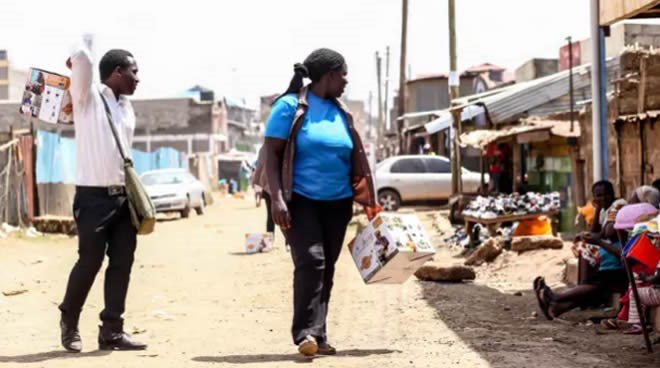
Wednesday, September 28, 2016
By Eleanor Ross

LivelyHoods sales agents selling clean cookstoves in the Kawangware slum in Nairobi, Kenya. Photo by: Eleanor Ross
When al-Shabab terrorist attacks began in northeast Kenya, Benta Miluki feared for her life. It eventually became too dangerous for her to remain in Mandera — a town just a few kilometers from the Somali border — so Miluki fled, leaving her job and friends behind. She arrived in Nairobi with nothing, but quickly spotted a poster advertising sales and marketing opportunities as part of a charity training program. Now, seven months later, she has a job that allows her to earn and support herself.
“I’m safer and happy,” she said.
Kenya is seeing a rise of “entrepreneurial” aid, or assistance in which agencies help those on the ground to help themselves through training and employment programs to battle high rates of youth unemployment, among other challenges. Such forms of aid tend to be active, rather than passive, and encourage participants to develop new skills and earn money simultaneously.
LivelyHoods is one example of a charity using an entrepreneurial structure. As a nonprofit based in Nairobi, Livelyhoods’ primary goal is to energize and employ young people and women, with a focus on those who live in slums. LivelyHoods encourages those who previously existed behind closed doors to become important parts of their communities using skills in sales and marketing, a little like Avon in 1960s America.
The products promoted or sold door-to-door aren't as whimsical as the lipsticks or hand creams of 50 years ago. Instead, LivelyHoods sells clean cookstoves that reduce emissions by half to housewives who are often at risk of inhaling carbon monoxide released by burning biomass. Participants in the training program are taught key selling and marketing tools free of charge, and then work in their own neighborhoods and slums to sell cookstoves to households.
Claire Baker, director of development at LivelyHoods, believes this focus on entrepreneurship is the way forward in sustainable change: “Fortunately, there is a general trend towards active aid in the development world, with many funders expecting a revenue model to be a part of development programming.”
Like LivelyHoods, Living Goods is based in Kenya and calls on entrepreneurial, or “active” aid, operating in Uganda, Burma and Zambia. It’s focused on community health promoters, who are trained to go door-to-door in a bid to improve awareness of disease and support pregnant women and newborns.
Lauren Brisbo, director of communications and marketing for Living Goods, thinks infusing business or entrepreneurial elements into traditional aid operations can be critical to increase motivation and deepen the impact of a charity.
Promoters earn a profit based on product sales and health assessment incentives, which helps to solve the main challenge of how to fund and motivate community health workers. Brisbo explained: “We motivate our CHPs through monetary incentives, regular performance management and ongoing support and training.”
There are always challenges associated with such projects. Helping the community understand why paying $32 for a new cookstove when there are school fees to be paid is difficult, according to Baker of LivelyHoods. Although the health benefits and eventual cost-savings are undeniable, $32 is a tough and sometimes unrealistic financial commitment to make when income is low, she added.
Other challenges involve getting the local community on board; involving local leaders like the local chief or religious leaders in decisions is something Baker takes seriously. Once a LivelyHoods branch is established, the organization ensures local ownership by hiring managers from nearby areas to lead it, she said.
Organizations that offer this type of training and ownership are likely to have a legacy effect as long as participation isn’t contingent on further funding, according to Tim Vorley, chair of entrepreneurship at Sheffield University Management School.
“In such instances, the challenge is to see the social benefits of the funded activities embedded into communities which can take ownership and responsibility,” Vorley said. “Then, we'll see continued impact.”
Vorley looks to entrepreneurial aid and social enterprise as a way to prevent aid from becoming one-sided and stagnant, a thought echoed by Living Goods’ Brisbo. Health promoters working with Living Goods, she said, are viewed as respected leaders within their communities, and when families get sick, they rely on their CHP at any time of day.
Vorley added that social enterprise and entrepreneurship can present effective solutions to some of the social challenges faced by local communities whether in the U.K. or Africa.
"While not a golden ticket perhaps, such endeavors represent innovation,” he said. “If a social enterprise is to have an ongoing social impact it needs to be in business — if the enterprise can't be sustained by definition, then the social impact is lost.
This might be an obvious point, he said, “but one which can be easily lost where the focus is predominantly on the social purpose.”
Learning training, sales and mentoring skills are vital in communities where educational programs can be hard to come across. Of the 2,000 youth and women who have completed the training program at LivelyHoods, 50 percent have gone on to become full-time sales agents. Many others have often secured another job, or pursued further studies or another entrepreneurial activity, she added.
It’s hoped such aid organizations will provide the first exposure to a structured working environment. With the blessing of local chiefs and leaders, an entrepreneurial aid program could be the first of many steps on the professional ladder.